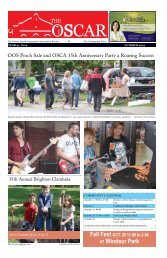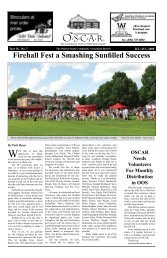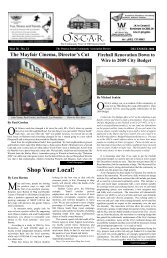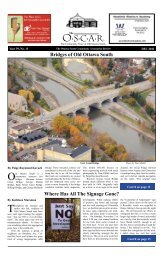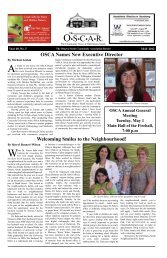O•S•C•A•R© Fida's Pizza Changes Hands - Old Ottawa South
O•S•C•A•R© Fida's Pizza Changes Hands - Old Ottawa South
O•S•C•A•R© Fida's Pizza Changes Hands - Old Ottawa South
You also want an ePaper? Increase the reach of your titles
YUMPU automatically turns print PDFs into web optimized ePapers that Google loves.
MAY 2010<br />
Primary Paleontologists Can Find Fossils Here In <strong>Ottawa</strong><br />
By Paige Raymond Kovach<br />
If your kids are like mine, they<br />
are fans of ancient herbivores<br />
and carnivores. Yet even though<br />
<strong>Ottawa</strong> wasn’t home to Brachiosaurus<br />
or Tyrannosaurus Rex, we have fossils<br />
right here for your favourite primary<br />
paleontologist to discover.<br />
The shales and limestones<br />
(sedimentary rocks) in and around<br />
<strong>Ottawa</strong> contain thousands of fossils.<br />
These fossils represent the life forms<br />
that once lived in the ancient seas that<br />
covered this region.<br />
We took the kids for a quick walk to<br />
Brown’s Inlet recently and they found<br />
some shale. Splitting the rock revealed<br />
a pattern. Was it a fossil? We had to find<br />
out what it was.<br />
Technically speaking these public<br />
lands are owned by the National<br />
Capital Commission so you must have<br />
permission before taking rocks or<br />
breaking them. Better to take photos<br />
of any fossils you find, and leave only<br />
footprints.<br />
“All the dingy, gray rocks you see in<br />
this area are from the Orvidician period<br />
and are over 440 million years old,”<br />
said Jean Dougherty, paleontologist at<br />
National Resources Canada.<br />
“The fossil you have in your picture<br />
has trackways or burrows made by a<br />
mud-dwelling creature. These creatures<br />
made a genetically set pattern in the<br />
mud we believe they used as a way of<br />
communicating to each other.”<br />
“The fossil you found was twice<br />
as old as the oldest dinosaur that ever<br />
lived.’ Said Ms. Dougherty, manager<br />
of the Earth Materials Collections of<br />
National Resources Canada.<br />
Or perhaps your kids have climbed<br />
and sat on fossils they weren’t aware of<br />
it.<br />
An <strong>Ottawa</strong> <strong>South</strong> mom introduced<br />
Squirrel Talk<br />
The weather keeps wavering as if on a ship at sea,<br />
making us reflect upon peoples’ impact on our<br />
world. This month’s soliloquy is from someone<br />
you might know, so we’ll leave you the pleasure of<br />
recognizing it. Read it in your mind or aloud, with the<br />
special verbal emphasis usually associated with this<br />
writer. Softly, it carries our spirits forward and gives<br />
our mind food for reflection.<br />
[…]<br />
Whether ‘tis nobler in the mind to suffer<br />
The slings and arrows of outrageous fortune,<br />
Or to take arms against a sea of troubles,<br />
And by opposing end them? To die: to sleep;<br />
No more; and by a sleep to say we end<br />
The heart-ache and the thousand natural shocks<br />
That flesh is heir to, ‘tis a consummation<br />
Devoutly to be wish’d.<br />
[…]<br />
The undiscover’d country from whose bourn<br />
No traveller returns, puzzles the will<br />
And makes us rather bear those ills we have<br />
Than fly to others that we know not of?<br />
Thus conscience does make cowards of us all;<br />
me to the fossils in some of the<br />
rectangular boulders in Brewer Park<br />
recently. “You can see some stacked<br />
columns of crinoids in some, some<br />
brachiopods, and corals if you look<br />
closely,” she said.<br />
According to Geoscape, the<br />
geology website of Natural Resources<br />
Canada, crinoids are a group of marine<br />
organisms that include starfish and sea<br />
urchins. Most forms consist of stalks<br />
with a series of stacked columns, a<br />
head-like structure and feathered arms.<br />
The most common fossil will be a<br />
single crinoid, or a few scales clumped<br />
together. Finding a whole crinoid is<br />
much more rare.<br />
If you and your kids still have the<br />
dinosaur bug, take your bikes, the bus<br />
or your car to visit Logan Hall. The free<br />
display of fossils, rocks, minerals and<br />
meteorites may just make your primary<br />
paleontologists into budding geologists<br />
too. My kids loved the meteorite found<br />
by a boy in St. Robert, Quebec. Logan<br />
Hall is located at 601 Booth Street,<br />
in the Geological Survey of Canada<br />
Building and is open Monday to Friday,<br />
8 a.m. until 4 p.m.<br />
The Canadian Museum of Nature<br />
is another great place to visit with your<br />
primary paleontologist. The second<br />
floor is devoted to dinosaurs. The<br />
museum is free on Saturday mornings<br />
from 9 a.m. until noon. Please note that<br />
the museum will be temporarily closed<br />
from April 26 until May 21, 2010 to<br />
prepare for its grand reopening.<br />
Resources<br />
Natural Resources Canada has a<br />
great website called Geoscape. In the<br />
lesson plans for the <strong>Ottawa</strong>-Carleton<br />
area there are great facts on our local<br />
fossils. http://geoscape.nrcan.gc.ca/<br />
ottawa/index_e.php<br />
Professor JA Davidson from<br />
Carleton used to give fossil fieldtrips as<br />
More Than Words!<br />
And thus the native hue of resolution<br />
Is sicklied o’er with the pale cast of thought,<br />
And enterprises of great pith and moment<br />
With this regard their currents turn awry,<br />
And lose the name of action.--Soft you now!<br />
part of a continuing education course.<br />
His itinerary is available on-line at<br />
http://http-server.carleton.ca/~jadonald/<br />
fieldtrips.html.<br />
<strong>Ottawa</strong> fossil index from Geoscape<br />
Crinoids are a group of marine<br />
organisms that include starfish and<br />
sea urchins. Most forms consist of<br />
stalks composed of a series of stacked<br />
columns of with a head-like structure<br />
and feathered arms. The most common<br />
fossil will be a single, or a few scales<br />
clumped together. A whole Crinoid is<br />
much rarer.<br />
Trilobites were marine creatures<br />
that moved just above the sea floor.<br />
Trilobite means three lobes, and if the<br />
creature were to be divided lengthwise<br />
it would have a centre lobe and two<br />
side lobes. Trilobites were hard-shelled<br />
creatures, and they had to shed their<br />
hard shell in order to grow. The shell<br />
is usually what fossil hunters find.<br />
More than words, reading this author (and many<br />
others) is an experience that changes each time we read<br />
the text, as our personal interpretation is influenced<br />
by our current and past experiences. This time we<br />
are reminded of recent Buddhist teachings we took:<br />
take no less yet no more than our place. A statement<br />
of simple appearance yet of hidden depth. Clearly a<br />
soliloquy such as above can lead us into a myriad of<br />
directions, and we choose to interpret it as a positive<br />
message.<br />
The comment this time relates to noise, and<br />
refers to the article in last month’s OSCAR on Patty’s<br />
Pub. We like having a pub nearby, but we find that<br />
it creates unacceptable noise at night. Perhaps if the<br />
owners helped respect the neighbourhood’s residential<br />
character then the situation referred to in last month’s<br />
OSCAR would not happen: “The only issue the pub<br />
has had at its present location has been a struggle […<br />
Page 17<br />
Three fossil hunting friends Oliver Waddington, Josh Rahaman, and George<br />
Kovach find some brachiopods in the shale boulders at Brewer Park.<br />
Photo by Paige Raymond Kovach<br />
Trilobites only lived in the Paleozoic<br />
era and are now extinct. If you find<br />
these types of fossils, you know how<br />
old the rock is -- between 545 and 250<br />
million years old.<br />
Cephalopods are ancient mollusks<br />
that were dominant large predators in the<br />
tropical seas that existed in the <strong>Ottawa</strong><br />
area. There are two main groups of<br />
fossil cephalopods, but only nautiloids<br />
are found locally and most have straight<br />
shells (orthocone). They lived in the<br />
<strong>Ottawa</strong> area from the Cambrian to the<br />
Ordovician era.<br />
Corals are irregular colonial masses<br />
that contain radically symmetrical, cupshaped<br />
living platforms that are larger<br />
than 1 mm in diameter. Many coral<br />
fossils are found in the <strong>Ottawa</strong> area,<br />
which suggests the climate was very<br />
different compared with today<br />
when] neighbours objected [when Patty’s Pub wished<br />
to open an outdoor patio].” When pub patrons leave<br />
at closing time in the middle of the night and are<br />
loud and noisy as they often are, then the pub itself<br />
becomes unwelcome. Another unfortunate recent<br />
example is that the pub forced the city to repair water<br />
valves during the night instead of letting the city do it<br />
in the morning as planned. This repair was so noisy<br />
that the sound reached through the whole house and<br />
lasted till early morning, so we couldn’t sleep for most<br />
of the night. Such actions from the pub plainly show<br />
they do not care about the neighbourhood. We ask<br />
the pub to act responsibly and thoughtfully towards<br />
the neighbourhood, and to ensure its patrons are<br />
respectful of the neighbourhood. Then the pub will<br />
be a very welcome neighbour. Would the pub actively<br />
commit to this ?<br />
We are the sum of all our actions and the sum<br />
of all our actions is the footprint we create. We can<br />
choose to better the world and our community by<br />
positive individual actions.<br />
Zen squirrels check us from the fence, sitting like<br />
little buddhas.<br />
Write us at taniamich@gmail.com.



